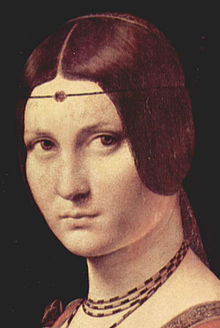


Aferronnière ([fɛʁ.ɔn.jɛʁ]) is a style of headband that encircles the wearer's forehead, usually with a small jewel suspended in the centre.[1] The original form of the headband was worn in late fifteenth-century Italy, and was rechristened a ferronnière at the time of its revival in the second quarter of the nineteenth century for both day and (more frequently) formal and evening wear.[2][3]
The term ferronnière for describing such headbands was probably coined in the early nineteenth century. Merriam-Webster date the earliest use of the term to 1831,[4] and the Oxford English Dictionary notes that their record of the earliest usage of the term is located in a mid-19th-century publication called World of Fashion.[5] Some sources suggest that the term was contemporary to the 1490s.[6][7][8]
The ferronnière is often said to be named after a 1490s portrait attributed to the school of Leonardo da Vinci, the La belle ferronnière, where the sitter wears such an ornament.[2][3][9][10] However, this painting's title was assigned in the 18th century,[11] well after it was painted, under the erroneous assumption that it portrayed Madame Le Féron, a reputed mistress of Francis I of France; or another mistress who was allegedly an iron merchant's wife.[9][10] The literal translation of ferronnière in English is "female ironmonger;" the term was used for the wife or daughter of an ironmonger.[10] In their catalogue, the Louvre suggest that La belle ferronnière was so-called because of her forehead ornament, a theory that is supported by other scholars,[11][12] but other sources conclude that the ornament was named after the painting, due to the term's specific application apparently not existing prior to the 19th century.[5][9][10]
The original ornament that later became called a ferronnière was popular in 15th-century Italy, where it could be made from metal or jewels.[6]
The nineteenth-century ferronnière was worn from the late 1820s to the early 1840s, when it was considered to enhance a high forehead, and by the 1850s, it had fallen out of fashion.[2] One contemporary source from 1831 describes the ferronnière as "a small plait of hair, adorned in the centre of the forehead by a large brilliant, from which depends another brilliant of the pear shape."[13] It has been described as one of the most widely worn examples of historicism in early Victorian fashion, worn as a tribute to the Renaissance alongside beaded belts called cordelières inspired by medieval clothing and hairstyles named after historic women such as Agnès Sorel and Blanche of Castile.[14] The ferronnière could be worn for either day or evening.[14] Alternative terms for similar ornaments were the bandelette and the tour de tête.[15][16]
La confusion a été facilitée par le bijou, appelé ferronnière, que le modèle porte sur le front.
The allusion is to a tour de tete, also known as a ferroniere, an oval or circular brow-ornament held in place by a thin chain. This fashionable ornament - which was said to give the wearer a look of 'erudition' - was copied from a painting by Leonardo da Vinci...
|
| |||||||||
|---|---|---|---|---|---|---|---|---|---|
|
|
| ||||||||
| Helmets |
| ||||||||
| Other protective |
| ||||||||
| Hairwear and other items |
| ||||||||
| Eyewear |
| ||||||||
|
| |||||||||||||
|---|---|---|---|---|---|---|---|---|---|---|---|---|---|
| Forms |
| ||||||||||||
| Making |
| ||||||||||||
| Materials |
| ||||||||||||
| Terms |
| ||||||||||||
| |||||||||||||